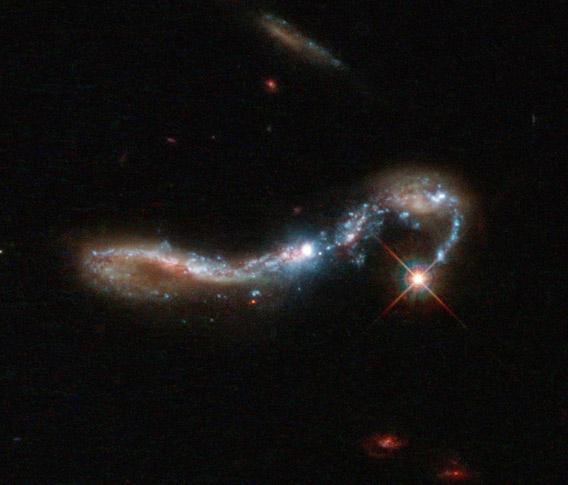I find all galaxies to be beautiful, from huge, symmetric elliptical puffballs to glorious, grand design spirals.
But man, J082354.96 is seriously messed up. It’s still beautiful, though:

Image credit: ESA/Hubble & NASA, M. Hayes
Wow. It’s quite the train wreck, and can definitely be labeled as “peculiar”. That’s an actual galaxy type, along with elliptical, disk (or spiral, like our Milky Way), and irregular. That last is for galaxies with no overall shape; peculiars have a definite shape, just a weird one.
J08 is about 650 million light years away, and clearly has something going on to give it this weird, drawn out, and oddly pleasing curvy hooked shape. To any astronomer’s eye, it’s obviously undergone an interaction: a cosmic collision with or nearby pass of another galaxy. That will commonly elongate a galaxy like this, and even cause those curls at the ends. As two galaxies collide (and sometimes merge), the huge collective gravities of each stretch the other out like taffy, and an off-center collision can cause vast arcs of gas and stars to be drawn out.
Interestingly, it’s not clear to me where the other galaxy is that did this. It’s possible they merged completely, forming J08 as we see it now, disturbed and weird but probably beginning to settle down after the eons-long encounter. If they didn’t merge, though, it’s difficult to say what happened to the other galaxy just from examining this image alone. There are a couple of galaxies near J08 in the full picture, but without knowing their distance they could be located much closer or farther from Earth than J08 itself, completely unrelated to it.
This galaxy was observed by Hubble to find out what it looks like in ultraviolet light, as part of a study the structure of these galaxies. UV is strongly emitted by hot, massive, blue stars, which don’t live very long. As it happens, J08 is a starburst galaxy, cranking stars out at a high rate. A lot of those stars are the massive and hot kind, and they light up the gas and dust around them—these are strung out along the galaxy, which you can see as those blue regions in the Hubble picture. This is actually pretty typical after a big galaxy collision; gas clouds collide, collapse, and form stars at a furious rate.
However, there’s more going on here. The UV light seen in the Hubble image above is pretty much emitted by stars and warm gas. But if you look farther into the ultraviolet, a new feature comes up, a very special color of UV strongly emitted by hydrogen gas. When you hit a hydrogen atom with enough energy, its sole electron will jump from one energy level to the next, like a person hopping up a step on a staircase. In this case, the electron jumps up from the bottom energy level to the next one up. After a time, it’ll plop back down and emit a UV photon at 121.6 nanometers wavelength (way outside what the human eye can see). This light is so special it has its own name: Lyman Alpha, or Lyα.
The astronomers studying J08 used the orbiting GALEX observatory to take a look at the Lyα being emitted in the galaxy. They processed the data to remove a lot of unwanted light interfering with the Lyα, and what they found is interesting:

Credit: ESA/Hubble & NASA, M. Hayes; GALEX
In the upper image (a combination of several observations from Hubble and GALEX), red shows light from warm gas clouds, green from the massive stars, and the Lyα (normally invisible to the human eye) is colored blue. As you can see, quite a bit of Lyα appears to be coming from the outskirts of the galaxy. It’s coming from the interior as well, but that’s overwhelmed by the other light and hard to see here. The point is that the Lyα emission is also coming from parts of the galaxy well beyond where we see visible light being emitted. J08 is an extreme example (the galaxy itself is stretched out) but they found similar results in about a dozen other galaxies they looked at as well.
It turns out that many galaxies are surrounded by a thin halo of hydrogen gas, but it’s very hard to detect because it’s spread out. It doesn’t emit optical light we can see, and it’s too cold to emit UV light on its own. But those massive hot stars are sending out light at all colors of UV, including Lyα, and the gas on the outskirts absorbs and re-emits it, betraying its presence. That’s why we see Lyα coming from the outer parts of the galaxy. The actual mechanism occurring is more complicated than this—isn’t it always?—but that’s the basics of it. J08 and the others were chosen because they’re relatively nearby, and their structures could be picked out by Hubble. Once we understand how and where Lyα is emitted by them, we can use that to better understand more distant galaxies where we can’t see the structure directly.
This is important to know because Lyα is used to determine how many hot, massive stars are born in these kinds of galaxies. It also reveals the structures of these galaxies, including the location of gas that is otherwise invisible. It’s also used in other ways, like finding the distances to galaxies and vast gas clouds, and even what conditions were like in the early Universe. All that from a simple quirk in the simplest atom of them all.
I find it fascinating that the Universe is so accommodating to our inquisitive nature. It leaves clues everywhere about itself, and all you need to learn about it is a bit of math and physics, technology, and above all curiosity. With those features in combination, the entire cosmos can be revealed.